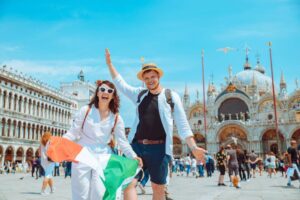Last Updated on 1 week ago by Nicky Johnson
The air chills. Twinkling lights appear in windows. Across the globe, the final month of the year ushers in a season of vibrant celebration, deep-rooted tradition, and joyful connection. But the festivities go far beyond Christmas, with dozens of cultures honoring their unique histories and hopes for the future.
Whether you’re a traveler planning a December getaway, a teacher crafting a lesson on world cultures, or a family looking to add new traditions to your celebration, this guide is for you. Journey with us through the month’s most fascinating holidays, and discover simple ways you can celebrate, too.
A Journey Through December’s Celebrations
Blog Contents
- A Journey Through December’s Celebrations
- Krampusnacht (Krampus Night)
- St. Nicholas Day
- Feast of the Immaculate Conception
- St. Lucia Day
- Las Posadas
- Hanukkah (The Festival of Lights)
- Winter Solstice & Yule
- Festivus
- Christmas
- Kwanzaa
- Boxing Day
- Ōmisoka (Japanese New Year’s Eve)
- New Year’s Eve
- Frequently Asked Questions
- Krampusnacht (Krampus Night)
- St. Nicholas Day
- Feast of the Immaculate Conception
- St. Lucia Day
- Las Posadas
- Hanukkah (The Festival of Lights)
- Winter Solstice & Yule
- Festivus
- Christmas
- Kwanzaa
- Boxing Day
- Ōmisoka (Japanese New Year’s Eve)
- New Year’s Eve
Krampusnacht (Krampus Night)
- When: December 5
- Who Celebrates: Primarily communities in Austria, Germany, Hungary, and other Alpine regions.
In Central European folklore, the kind-hearted St. Nicholas doesn’t travel alone. He’s accompanied by Krampus, a horned, demonic figure who playfully punishes naughty children while St. Nick rewards the good. On Krampusnacht, the eve of St. Nicholas Day, people—especially young men—dress up as these frightening figures for “Krampus runs” (Krampuslauf), parading through the streets to create a thrilling, spooky spectacle.
🎉 Actionable Idea for Families: While a full Krampus costume might be a bit much, you can explore the fun “naughty or nice” folklore by reading stories about Krampus and St. Nicholas and discussing the importance of good deeds.
St. Nicholas Day
- When: December 6
- Who Celebrates: Christians across Europe, especially in the Netherlands, Germany, Belgium, and Eastern Europe.
Long before Santa Claus and his sleigh, there was St. Nicholas, a 4th-century Greek bishop known for his incredible generosity. St. Nicholas Day honors this patron saint of children, sailors, and merchants. Instead of waiting for Christmas morning, many European children leave a shoe or a boot outside their door on the evening of December 5. In the morning, they hope to find them filled with small gifts, coins, and candy, courtesy of St. Nicholas himself.
🎉 Actionable Idea for Families: Adopt this charming tradition! Have your kids leave a shoe by their bedroom door or the fireplace on the night of December 5 and fill it with a small treat like chocolate coins or a new pair of fun socks.
Feast of the Immaculate Conception
- When: December 8
- Who Celebrates: Catholics around the world.
This important holy day in the Catholic Church celebrates the belief that Mary, the mother of Jesus, was conceived without original sin. It’s a day of reflection, prayer, and special church services. In many countries, it’s a national holiday marked by parades, processions, and family feasts. In Rome, the Pope traditionally leads a ceremony near the Spanish Steps, honoring the Virgin Mary.
✈️ Actionable Idea for Travelers: If you’re in a Catholic country like Spain, Italy, or the Philippines on this day, look for public processions and visit historic cathedrals to see them beautifully decorated for the occasion.
St. Lucia Day
- When: December 13
- Who Celebrates: Primarily people in Sweden, Norway, and Swedish-speaking parts of Finland.
A festival of light in the darkest time of year, St. Lucia Day (or St. Lucy’s Day) is one of Scandinavia’s most beautiful traditions. It honors a 3rd-century martyr who was said to have brought food to Christians hiding in catacombs, wearing a wreath of candles on her head to light her way. Today, the tradition is brought to life by a young woman chosen to portray St. Lucia, who leads a procession of singers while wearing a white gown and a crown of candles.
🍪 Actionable Idea for Foodies: Bake Lussekatter, traditional S-shaped saffron buns studded with raisins. Their bright yellow color and sweet taste are a perfect way to bring a little light and warmth into a dark December day.
Las Posadas
- When: December 16–24
- Who Celebrates: Communities in Mexico, Guatemala, and parts of the United States.
Las Posadas, Spanish for “The Inns,” is a nine-day celebration reenacting Mary and Joseph’s difficult journey from Nazareth to Bethlehem. Each night, a procession of children and adults, often holding candles and singing villancicos (carols), travels through the neighborhood. They knock on doors, asking for shelter, and are ceremonially “turned away” until they reach a designated host home, where they are finally welcomed inside for a fiesta with food, music, and a piñata.
🎶 Actionable Idea for Educators: Teach your students a simple villancico like “Campana Sobre Campana.” You can also make simple paper bag luminarias (paper lanterns) to capture the beautiful, candlelit spirit of the processions.
Hanukkah (The Festival of Lights)
- When: A floating holiday that occurs between late November and late December. It’s determined by the Hebrew calendar (starts on the 25th of Kislev).
- Who Celebrates: Jewish people worldwide.
Hanukkah is an eight-day celebration commemorating the rededication of the Second Temple in Jerusalem in the 2nd century BCE. After a small band of Jewish warriors (the Maccabees) reclaimed the temple from occupiers, they found only enough pure oil to light the temple’s menorah for a single day. Miraculously, the oil burned for eight days. To honor this event, families light one candle on the menorah each night for eight nights, play games with a spinning top called a dreidel, and eat foods fried in oil, like latkes (potato pancakes) and sufganiyot (jelly-filled donuts).
🎉 Actionable Idea for Families: Make a batch of crispy potato latkes to share! It’s a delicious, hands-on way to connect with the holiday’s central theme of the miracle of oil. Serve them with applesauce and sour cream.
Winter Solstice & Yule
- When: Around December 21 or 22 in the Northern Hemisphere.
- Who Celebrates: People of many different cultures and spiritual paths, including pagans and Wiccans.
The Winter Solstice is an astronomical event marking the shortest day and longest night of the year. For millennia, cultures have celebrated it as a powerful moment of rebirth—the symbolic return of the sun and the promise of longer days to come. Ancient Romans had Saturnalia, and Germanic and Norse peoples celebrated Yule. Modern Yule celebrations often involve gathering with loved ones, lighting a Yule log, decorating with evergreens, and reflecting on the quiet darkness before the return of light.
🌲 Actionable Idea for the Culturally Curious: Embrace the natural theme of the solstice. Go for a walk in nature, decorate your home with evergreen boughs and pinecones, or simply light a candle and spend a few quiet moments reflecting on the past year and setting intentions for the new one.
Festivus
- When: December 23
- Who Celebrates: Fans of the 1990s sitcom Seinfeld and anyone with a good sense of humor.
“A Festivus for the rest of us!” This hilarious, non-commercial holiday entered pop culture through a 1997 Seinfeld episode. Billed as an alternative to the pressures of Christmas, Festivus traditions include the Airing of Grievances (where you tell others how they’ve disappointed you all year), the Feats of Strength (where the head of the household must be wrestled and pinned), and celebrating around an unadorned aluminum pole.
😂 Actionable Idea for Fun: Host a lighthearted “Airing of Grievances” with friends. Instead of being serious, share funny pet peeves from the past year. It’s a great way to laugh off some stress.
Christmas
- When: December 25
- Who Celebrates: Christians and many non-Christians worldwide.
Christmas celebrates the birth of Jesus Christ. While its roots are religious, it has also become a massive cultural holiday celebrated by billions. Traditions vary immensely by region but often include decorating Christmas trees, singing carols, attending church services, sharing a festive meal, and exchanging gifts brought by figures like Santa Claus, Father Christmas, or Saint Nicholas.
✈️ Actionable Idea for Travelers: Visit a European Christmas market. Cities like Vienna, Prague, and Strasbourg transform into winter wonderlands with charming stalls selling handmade crafts, mulled wine (Glühwein), and local holiday treats.
Kwanzaa
- When: December 26–January 1
- Who Celebrates: Millions of African Americans and others in the African diaspora.
Created in 1966 by Dr. Maulana Karenga, Kwanzaa is a week-long celebration of African heritage and culture. The holiday is centered around the Nguzo Saba, or the Seven Principles: Umoja (Unity), Kujichagulia (Self-Determination), Ujima (Collective Work and Responsibility), Ujamaa (Cooperative Economics), Nia (Purpose), Kuumba (Creativity), and Imani (Faith). Each night, a candle is lit on a holder called a kinara, and one of the principles is discussed. The week culminates in a feast called Karamu on December 31.
🤝 Actionable Idea for Educators: Introduce the Seven Principles to your classroom. Assign small groups to research one principle and present what it means to them and their community, fostering a sense of unity and purpose.
Boxing Day
- When: December 26
- Who Celebrates: Primarily people in the United Kingdom and other Commonwealth nations like Canada, Australia, and New Zealand.
The origins of Boxing Day are debated, but the most popular theory is that it was the day when the upper class would “box up” gifts for their servants and tradespeople. It was a day off for them to celebrate with their own families. Today, it’s a public holiday known for relaxing with family, eating Christmas leftovers, watching sports, and shopping for big sales.
🎁 Actionable Idea for Families: Reconnect with the original spirit of Boxing Day by doing an act of service. “Box up” canned goods for a local food drive, donate old coats to a shelter, or make a contribution to a favorite charity.
Ōmisoka (Japanese New Year’s Eve)
- When: December 31
- Who Celebrates: People throughout Japan.
In Japan, New Year’s Eve, or Ōmisoka, is about closing out the old year to enter the new one fresh and purified. Many families perform ōsōji, a deep “big cleaning” of their homes. In the evening, it’s traditional to eat toshikoshi soba (“year-crossing noodles”). The long noodles symbolize a long and healthy life. As midnight approaches, many families watch Kōhaku Uta Gassen, a popular song contest on TV, and listen for the sound of Buddhist temple bells being rung 108 times to cleanse humanity of the 108 worldly desires.
🍜 Actionable Idea for Foodies: Try making a simple bowl of toshikoshi soba at home. You can find buckwheat soba noodles and dashi broth at most Asian grocery stores. It’s a simple, meaningful, and delicious way to ring in the new year.
New Year’s Eve
- When: December 31
- Who Celebrates: People all over the world.
The final day of the Gregorian calendar, New Year’s Eve, is a near-universal celebration of farewells and fresh starts. While customs vary, the spirit is the same: ringing out the old and ringing in the new. Celebrations range from massive public fireworks displays in Sydney and packed crowds in New York’s Times Square to quiet family gatherings. It’s a moment for reflection, resolution, and hope for the year to come.
✍️ Actionable Idea for Everyone: Take a few minutes before the festivities begin to write down your favorite memory from the past year and one thing you’re hopeful for in the new year. It’s a powerful personal tradition to start.
Frequently Asked Questions
Why do the dates for Hanukkah change every year?
Hanukkah follows the Hebrew calendar, which is a lunisolar calendar based on the cycles of the moon. Because this calendar doesn’t align perfectly with the 365-day Gregorian solar calendar that most of the world uses, the date for Hanukkah shifts each year.
What’s the difference between the Winter Solstice and Yule?
The Winter Solstice is an astronomical event—the day with the least amount of daylight. Yule is a traditional festival, historically celebrated by Germanic peoples, that takes place on or around the solstice to honor this turning point of the seasons.
Is Boxing Day just a day for shopping?
While it has become a major shopping day similar to Black Friday in the U.S., its origins are rooted in charity and giving. Many people still celebrate it as a quiet day to relax with family and recover from Christmas festivities.







